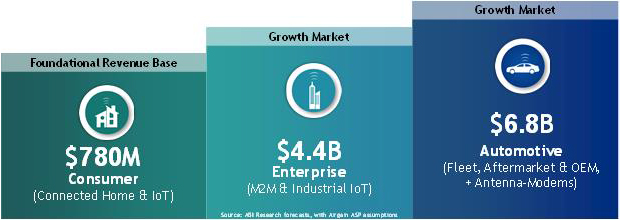Airgain is a leading provider of advanced wireless connectivity solutions and technologies used to enable high performance wireless networking across a broad range of devices and markets, including consumer, enterprise, and automotive. Our mission is to connect the world through advanced antenna systems and integrated wireless solutions. Combining
design-led
thinking with testing and development, our technologies are deployed in carrier, fleet, enterprise, residential, private, government, and public safety wireless networks and systems, including
set-top
boxes, access points, routers, modems, gateways, media adapters, portables, digital televisions, sensors, fleet, and asset tracking devices. Through our pedigree in the design, integration, and testing of high performance embedded antenna technology, we have become a leading provider to the residential wireless local area networking, also known as WLAN, market, supplying to leading carriers, original equipment manufacturers, or OEMs, original design manufacturers, or ODMs, and chipset manufacturers who depend on us to achieve their wireless performance goals.
We built the foundation of our business through the evolution of the IEEE 802.11 protocol standards, and our roots are steeped in
Wi-Fi
antennas. Over the years, we have diversified our wireless connectivity solutions into cellular communications, starting with 3G technology, leading to LTE and more recently, 5G. As the number of wireless standards has increased, we have adapted to develop the necessary solutions to meet end customer needs.
Our core business historically was primarily sales of embedded antenna solutions for the top North American video service providers, largely in the consumer market. As technology advanced from 3G and pre-802.11ac protocol, antennas were often overlooked in terms of importance despite being a necessary component. More recently, the number of antennas per device has increased, the number of frequency bands to be supported per device has increased, device form factors have become smaller, product refresh cycles have shortened, and RF performance requirements have become more stringent. This evolution has made the antennas the limiting factor in the performance of many of today’s devices. As we head into
Wi-Fi
6 which addresses more dense areas, and 6E which adds additional spectrum for
Wi-Fi,
and 5G, both
sub-6GHz
and mmWave, we believe the market is moving straight into Airgain’s core competency and creating new opportunities for growth, particularly in our enterprise and automotive markets, where we have been targeting research and development investment in recent years. We are leveraging our experience in embedded antenna solutions and the evolving technology landscape to transition from a passive antenna and related services provider to a wireless system solutions provider.
Our embedded antenna solutions and related design and test services, which has historically been our core business, is predominant to our consumer market, but also is a significant component of our enterprise market, and to a lesser extent, automotive markets. In delivering embedded antenna solutions our design teams partner with customers from the early stages of antenna prototyping to device throughput testing to facilitate optimal performance and quick time to market. Our capabilities include design, custom engineering support, integration, and
or OTA, testing. These capabilities have resulted in a strong reputation across the OEM, ODM and chipset manufacturer ecosystem. Our competencies and strengths have helped us secure design wins used in multiple reference designs from leading
Wi-Fi
chipset vendors. OEMs, ODMs, chipset manufacturers and service providers rely on these reference designs and our engineering skills to deliver superior throughput performance. We view our relationships with OEM, ODM, chipset and component manufacturers, and service providers and carriers as an important attribute to our long-term strategy and success. As a wireless connectivity solution provider that has a history in antenna technology, antennas are a part of everything we do, embedded or otherwise.
We have over 1,000 antenna products in our portfolio which shipped worldwide and are implemented across millions of devices. During 2020 we supplied our products to carriers, retailers, OEMs, ODMs and end users in three primary geographic regions: North America, Europe, and Asia Pacific. Our customer base includes Aruba, Cisco, AT&T (DIRECTV U.S., LLC), Belkin International, Inc., Broadcom, Charter Communications, Inc., Comcast Corporation, Commscope, Inc., Dish Network, Liberty Global plc., Nokia, Telefonica SA, Sagemcom SAS, Samsung, Technicolor SA and ZTE Corporation, among others. We have achieved significant growth in our business, and from 2012 to 2020 our annual sales have grown from $18.2 million to as high as $60.6 million in 2018.
Our embedded and external antenna solutions support a variety of wireless access technologies across the licensed and unlicensed spectrum of frequency bands. These include IEEE 802.11 a/b/g/n, 802.11ac and ax (now called
Wi-Fi
6), 3G, LTE, 5G, low power wide area (or LPWA), as well as wireless internet of things, or IoT, standards such as Bluetooth, ZigBee and
Z-Wave,
among others. In addition, we have expertise in the testing and benchmarking of passive and active wireless systems and devices including
Wi-Fi
6 and 5G cellular. To satisfy the rapidly evolving technology needs of the industry, we have remained on the leading edge of next generation development by aligning ourselves with the evolution of wireless standards and working with wireless chipset vendors and our OEM partners on
and reference designs from very early in the new product development cycle, ensuring our solutions are ready in advance or in time for customer product implementations of new technology.
